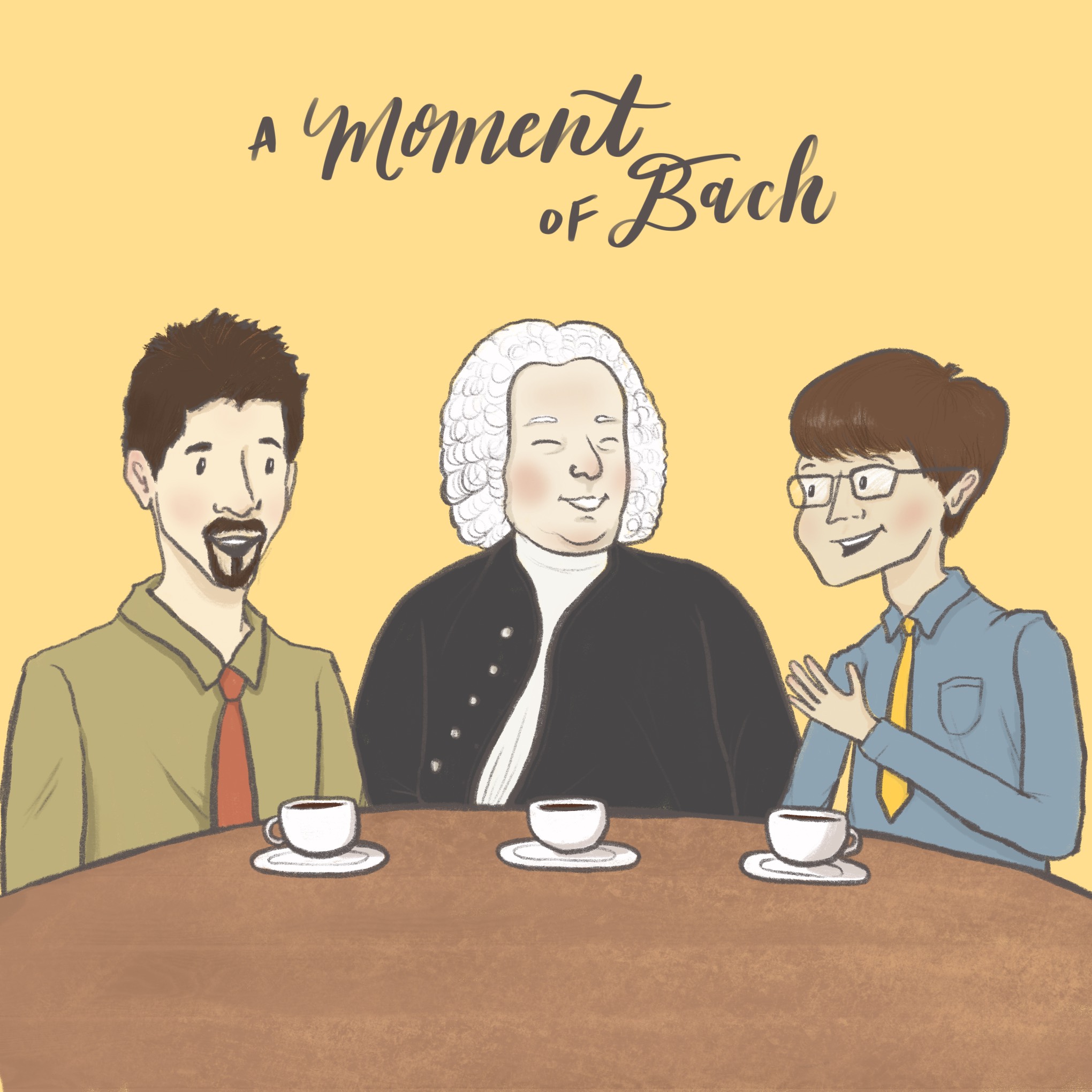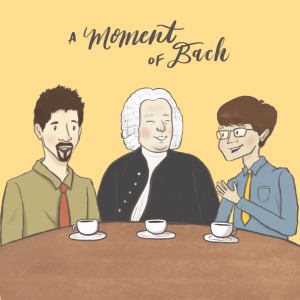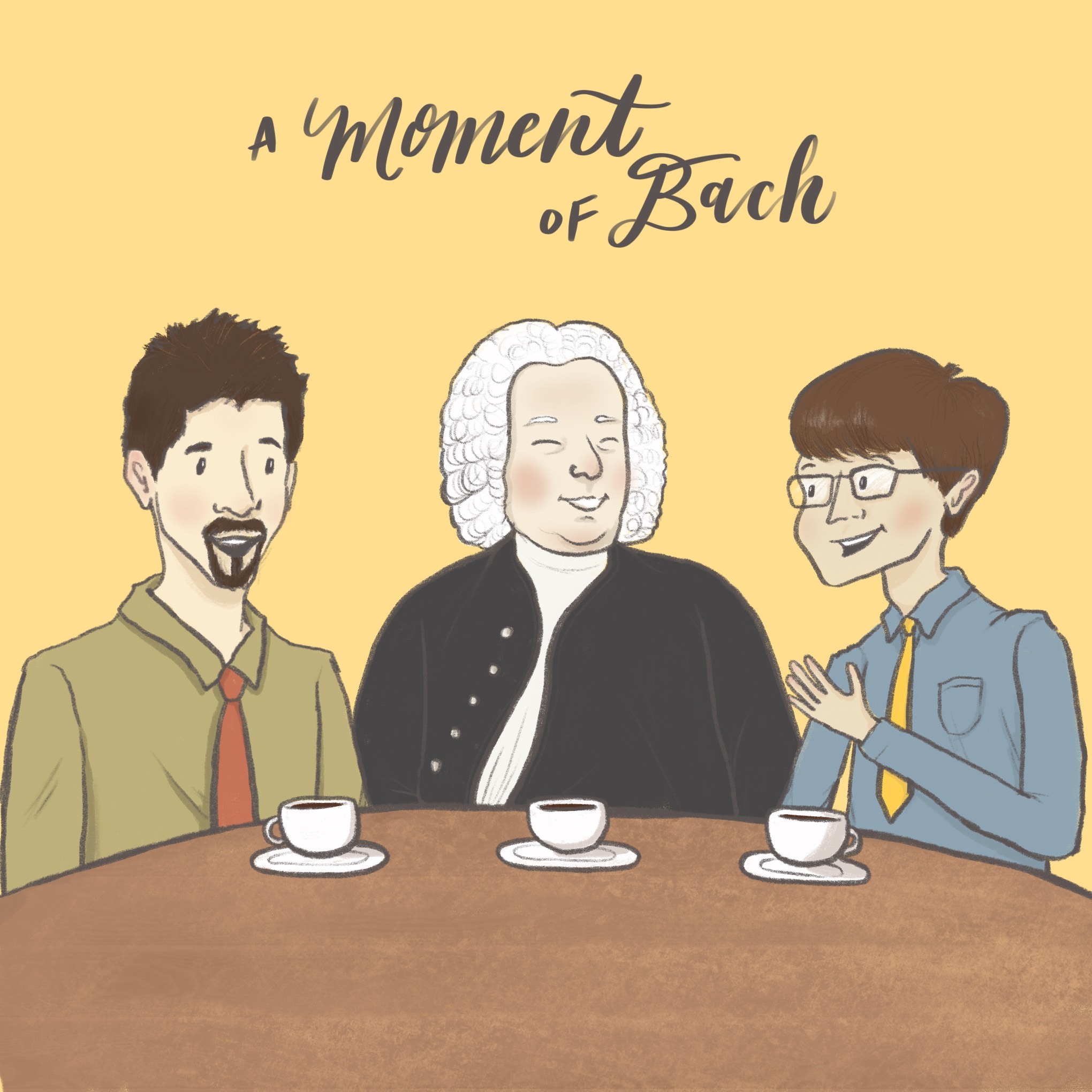
244.4K
Downloads
176
Episodes
Welcome to A Moment of Bach, where we take our favorite moments from J. S Bach's vast output—just a minute's worth or even a few seconds—and show you why we think they are remarkable. Join hosts Alex Guebert and Christian Guebert for weekly moments! Check wherever podcasts are available and subscribe for upcoming episodes. Our recording samples are provided by the Netherlands Bach Society. Their monumental All of Bach project (to perform and record all of the works of J. S. Bach) serves as source material for our episodes. https://www.bachvereniging.nl/en https://www.bachvereniging.nl/en/allofbach Artwork by Sydney LaCom
Episodes

Monday May 16, 2022
Brandenburg Concerto No. 4: movement 1
Monday May 16, 2022
Monday May 16, 2022
Welcome to our miniseries on Brandenburg Concerto No. 4! In this first episode, we will talk about the first movement.
Bach's Brandenburg Concertos are considered by many to be the pinnacle of instrumental Baroque music. Come and join us as we explore why. This episode explores the many small building blocks that come together to make the first movement of this concerto into something greater than the sum of its parts. Two agile recorders compete with a showy violin part, all accompanied by a background orchestra (which isn't really in the background). How can we pick a single moment from this dense kaleidoscope of musical devices? Let's look at several of those devices in this episode.
Stay tuned for the next two episodes in this miniseries, where we explore movements 2 and 3.
Brandenburg Concerto No. 4 in G major BWV 1049 as performed by Netherlands Bach Society: https://www.youtube.com/watch?v=oSZJ__GIbms
Ter Schegget and Sato on Bach Brandenburg Concerto No. 4 BWV 1049 | Netherlands Bach Society: https://www.youtube.com/watch?v=yKAPxpBlh3Q

Monday May 09, 2022
Nun komm, der Heiden Heiland (organ chorale prelude, BWV 659)
Monday May 09, 2022
Monday May 09, 2022
Passed down to us through almost two millennia, the poem that would later become "Savior of the Nations, Come" was set to a plainchant melody in the Middle Ages, and that melody was given a strong, angular treatment by Martin Luther, who also adapted and translated the text. A couple centuries later, it was Bach's turn to create something new from this storied hymn -- and he did, multiple times. This organ prelude may be one of Bach's more austere arrangements of this hymn, but he couldn't help adding some clever complexity to it.
We talk about how an extended ending can add much-needed closure to a piece. We also talk about how Bach is like a stained glass window -- colorful, complex, subtle, beautiful, illuminating core religious truths.
BWV 659 played by Leo van Doeselaar for the Netherlands Bach Society:

Monday May 02, 2022
Concerto for two violins in D minor (BWV 1043): 3rd movement
Monday May 02, 2022
Monday May 02, 2022
This is the second episode of our double-part look at the "Bach Double" violin concerto. In this episode, we hear how one moment of expressive subtlety can demonstrate the difference between "flashy fast notes" and true baroque emotion. A single "sighing" motif written as plain eighth notes demonstrates to us that the musicians of Bach's time were trained in a high art of ornamentation, and if they just played the notes on the page, the result would have fallen flat.
Netherlands Bach Society performing the "Bach Double" (mvt. 3); Shunske Sato and Emily Deans, violin soloists:
https://www.youtube.com/watch?v=ILKJcsET-NM&t=592s
Sato and Deans' interview on the piece:

Monday Apr 25, 2022
Concerto for two violins in D minor (BWV 1043): 2nd movement
Monday Apr 25, 2022
Monday Apr 25, 2022
Contrast -- a major aspect of all good art. The striking colors of a sky at sunset, the thrilling first few notes of "Et resurrexit" from the Mass in B minor, or the shadowed look of a chiaroscuro painting -- all are much more powerful for the presence of sharp contrast.
In this episode we explore how Bach uses contrast in the sublime middle movement of the "Bach Double", otherwise known as the Concerto for two violins in D minor. The interplay of the two soloists is tender and personal, with an almost empathetic quality.
Netherlands Bach Society performing the "Bach Double"; Shunske Sato and Emily Deans, violin soloists:
https://youtu.be/ILKJcsET-NM?t=231
Clip from Mozart Requiem: Weiner Philharmoniker and Wiener Hofmusikkapelle, Decca, 1951, Creative Commons License Zero 1.0 (Universal Public Domain).

Monday Apr 18, 2022
Mass in B minor: Et resurrexit
Monday Apr 18, 2022
Monday Apr 18, 2022
In celebration of Easter, we complete the pair of parts including last week's "Crucifixus." In one of the most stunning reversals in all of music, Christ is laid into the dark grave in the lowest of lows, when suddenly "And he rose again on the third day..." bursts forth with triumphant celebration.
Bach was a master of text. Without rushing past the dramatic parts of the story told in the Nicene Creed, he separates movements like these two for maximum contrast at those iconic first few seconds of "Et resurrexit." His personality as a composer (or, really, lack thereof) is different and less flashy from the way we see modern musicians and their fame. It is almost as though he represents a collective soul of his culture; he so neatly synthesized all of the forms that came before him and used them in complete service of this religious text. Bach is a terminal point of music like none other.
Performance of "Et resurrexit" as part of the performance of the Mass in B minor by the Netherlands Bach Society:

Monday Apr 11, 2022
Mass in B minor: Crucifixus
Monday Apr 11, 2022
Monday Apr 11, 2022
Some of the most evocative and emotional music ever written, the "Crucifixus" movement from the Mass in B minor depicts Christ's suffering and death -- you can hear the striking lashes, the plodding steps of His painful walk to Golgotha, the twisting of the crown of thorns, the nailing and the crying, the sighing and the dying. Bach's use of the passacaglia form here leads to the possibility of extreme dissonances, all within the creative framework of a repeated bass line, which sounds as if it is endlessly marching down, down, down... Full of remarkable moments, the "Crucifixus" movement -- this masterwork within a masterwork -- will never cease to amaze us.
Performance of "Crucifixus" by four soloists and orchestra, as part of the performance of the Mass in B minor by the Netherlands Bach Society:

Monday Apr 04, 2022
St. John Passion: ”Ich folge dir gleichfalls” aria
Monday Apr 04, 2022
Monday Apr 04, 2022
A dark and imposing masterwork like the St. John Passion needs a moment of joyful reprieve. That reprieve comes in the form of the soprano aria ”Ich folge dir gleichfalls mit freudigen Schritten" (I too, follow you with joyful steps), in which we hear light flutes bouncing their steps. But even this happy sound comes with a strange chromatic ascent as the soloist sings "do not cease to push me, to pull me...". The St. John Passion is partly an instructive drama about how to follow Jesus; Peter must do his best at this despite his faults and denials. With this moment in this aria, we are dramatically pulled by Christ back into his own passion story.
St. John Passion: ”Ich folge dir gleichfalls” aria as performed by the Netherlands Bach Society: https://youtu.be/zMf9XDQBAaI?t=1315

Monday Mar 28, 2022
St. John Passion: ”Herr, unser Herrscher” opening chorus
Monday Mar 28, 2022
Monday Mar 28, 2022
Today we take our first dive into the St. John Passion. In the very first measure of music, the strikingly twisted sounds of the oboes in harsh dissonances calls to mind the pain and anguish of the Passion story. The scene is set for Good Friday.
Bach's St. John Passion, performed by the Netherlands Bach Society, conducted by Jos van Veldhoven:
https://www.youtube.com/watch?v=zMf9XDQBAaI
Article on the St. John Passion by Alex Ross (quoted in this episode from 0:41 - 1:49):
https://www.newyorker.com/magazine/2017/01/02/bachs-holy-dread
IMSLP (International Music Score Library Project) page for Bach's St. John Passion free public domain scores, including scans of Bach's original manuscript:
https://imslp.org/wiki/Johannespassion,_BWV_245_(Bach,_Johann_Sebastian)

Monday Mar 21, 2022
St. Matthew Passion: ”Barrabam!” and ”Wahrlich...” moments
Monday Mar 21, 2022
Monday Mar 21, 2022
The St. Matthew Passion is full of short bursts of dramatic expression. In this episode, we explore two moments of reaction by an onlooking crowd.
One of Bach's shortest and most surprising moments happens when Pontius Pilate asks the crowd which prisoner should be released -- Jesus, or Barrabas? The crowd's reply is as disturbing as it is musically shocking.
Another moment happens later, after the earthquake and chaos immediately after Christ's death. After the frantic narration, the guard and crowds speak. But this moment is not one of pure terror, but rather sublime realization: "Truly, this was the Son of God." Bach's transparently gentle setting of this sentence is unforgettable.
An "A Moment of Bach" listener suggested the two topics for this episode! Do you want to suggest your own? https://amomentofbach.com/

Monday Mar 14, 2022
St. Matthew Passion: ”Aus Liebe” aria (mvt. 49)
Monday Mar 14, 2022
Monday Mar 14, 2022
Sometimes the simplest expression is the most powerful. At a pivotal point in the intimidating and complex St. Matthew Passion, Bach places this strikingly stark, simple, yet devastating piece of music. We discuss how the sparse instrumentation, with its lack of bass sounds, leaves the listener unmoored, feeling the vulnerability of the soloist's emotion. And Alex talks about a "moment of West Wing", so to speak.
St. Matthew Passion, performed by the Netherlands Bach Society (this link takes you directly to the "Aus Liebe" aria, with soprano Griet de Geyter):
https://youtu.be/ZwVW1ttVhuQ?t=6362
Scene from "The West Wing" that features Josh's favorite "Ave Maria" moment:
